Anyone who’s ever played a sport is familiar with the agony of defeat. But many athletes — whether they be weekend warriors or marathon masters — are also familiar with another kind of very real agony: the sports injury.
During activities in which we move unpredictably at high speeds, collide with other human beings, leap, spin, and swing, the chance for something to go wrong is high. Yet there are some things we can do to help injury-proof our bodies (which, coincidentally also make us better athletes) so that the next time we take to the field or court, we’ll hopefully experience the thrill of victory without agony of any kind.
Area of Injury: Shoulders
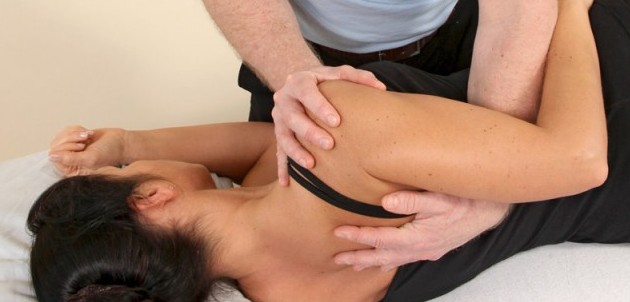
Because the shoulder tends to be a relatively tight joint, activities that require the arms to be raised above the head can cause the mechanics of the shoulders to begin showing signs of wear. When the bones in the shoulder socket get too close to each other, they can cause impingement syndrome in which the rotator cuff muscles or other shoulder tendons are pinched, causing them to get painfully inflamed. If the inflammation continues, the rotator cuff or tendons can tear, a condition that sometimes requires surgery. Another common shoulder injury occurs when the bursae of the shoulder get inflamed. These tiny sacs of fluid insulate tendons from skin and bone, and when they get inflamed from overuse or improper shoulder alignment, a painful condition known as bursitis occurs.
Prevention: The most successful exercises for shoulder-injury prevention have to do with strengthening and stretching the rotator cuff — typically through the use of rubber exercise bands. Both internal and external rotation movements should be performed. For external rotations, the arms should be at your side, and your hands should be raised in front of you, thumbs up, creating a 90 degree bend in the elbow. Wrap the band around your hands and gently push your hands and forearms out to each side, away from each other. For internal rotations, attach the band to a railing or other fixed object and, using the same position as above, grab the band with one hand and bring your hand and forearm across your body. For a good shoulder stretch, take a towel in one hand and hold it behind your head. Grab the other end of the towel behind your back. Use your top hand to pull your lower hand gently upwards, causing a stretch in the shoulder on that side.
Area of Injury: Elbow
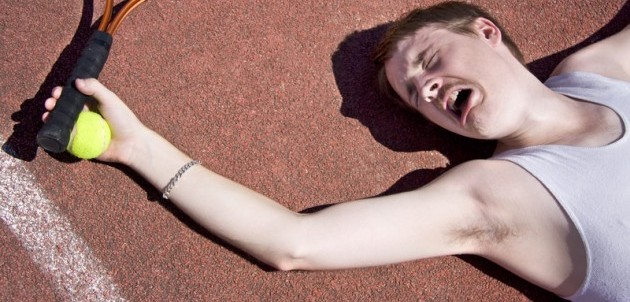
Elbow injuries take two primary forms named after the sports that can lead to their development: tennis elbow and golfer’s elbow. Both conditions occur in the area in which muscles and tendons attach to the bones of the elbow and can happen from an abrupt injury or from repetitive use. Although as many as 50% of tennis players will get the injury during their career, it can also occur in the general population as a repetitive-motion injury from activities like typing or using a computer mouse. With tennis elbow, a painful spot develops on the outside of the elbow, while with golfer’s elbow, the pain is on the inside. The pain can be felt either by touch, such as resting your elbows on the table, or when you shake someone’s hand or lift a heavy object that requires you to squeeze it first.
Prevention: A brace worn just below the elbow can help prevent both tennis and golfer’s elbow by helping to dampen the vibrations and impact that reach the joint. Look for an adjustable band that has a bulge in the area that would press into your forearm. Warming up the forearm muscles before any athletic activity can help as well. This can be done by placing the hands face-up on a table and touching each finger individually with the thumb, or by resting your forearms on your thigh with the hands up, balling your fists and rotating them clockwise and counterclockwise. Stretching the forearms can also help. Do this by putting your palms on a tabletop with your fingers pointing back at your body. Lean gently backwards and you’ll feel a stretch along the inside of your forearms. To strengthen the muscles involved in this type of injury, you can either squeeze a tennis ball or rolled up sock, or do wrist curls with a light dumbbell both with your palms facing upwards and downwards.
Area of Injury: Knees
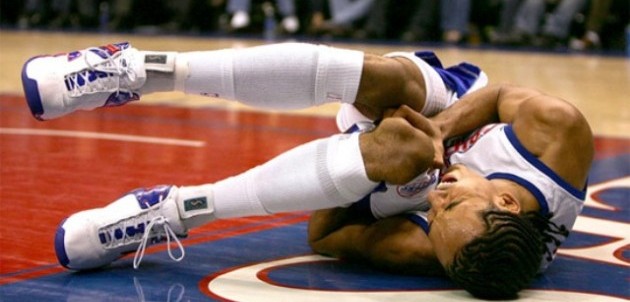
Among sports injuries, one of most well known and most feared is damage to the ACL, the anterior cruciate ligament. It’s a critical connector in the knee joint and “blowing it out” can mean months on the bench and, in some cases, can prevent an athlete from ever returning to their sport. The ACL works along with the PCL (posterior cruciate ligament). LCL (lateral collateral ligament) and MCL (medial collateral ligament) to connect the bones above the knee with those below it, and they can all suffer damage from sports like football, soccer, hockey, skiing and any other sports that require unexpected demands on the knee joint such as stopping suddenly, twisting with the foot planted or overextending the knee.
Prevention: Unlike sports injuries caused by repetitive motion such as rotator cuff or elbow issues, damage to the ligaments of the knee are a little more difficult to prevent as it often happens as part of a one-time accident. Still, the key here is also strengthening and stretching. Athletes should warm up with some light aerobic activity for approximately five minutes and then stretch the calves, quadriceps and hamstrings. The strengthening component of the injury-prevention recipe comes in two parts: standard and plyometric. Standard exercises should include walking lunges, calf raises and hamstring-strengthening movements like reverse leg curls or one-legged cable kickbacks. Plyometric exercises are those that make use of explosive movements. To help bring stability to the knee joints, you can try lateral jumps (where you jump side to side over a line or other other object), scissor jumps (where you begin in a lunge position, jump upwards and switch legs), or running butt kicks (where you jog lightly but do your best to get your heels to lightly tap your butt as you move along).
Area of Injury: Ankle
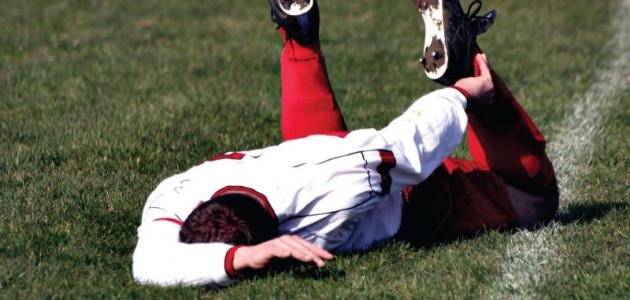
For a relatively small joint, the ankle is a powerhouse of human locomotion. It is the area in which two bones of the leg — the tibia and fibula — meet the foot bone known as the talus, and it is all held together with a network of muscles and tendons. In every step we take, the ankle helps to stabilize us and propel us forward. When the ankle is made to move in a direction to which it is not accustomed — as is often the case in certain sports — the tendons can tear, causing a ankle sprain. In fact, according to the Mayo Clinic, half of all ankle sprains happen as the result of athletic activities.
Prevention: To help prevent the ankle rolls and twists that can take months to heal, it is recommended that you strengthen the muscles in the joint. One of the easiest ways to do this is through ankle rotations. Simply sit and raise your foot off the ground. Then, circle your foot ten times clockwise and ten times counterclockwise. You can also use a rubber “theraband” to help strengthen your ankle by wrapping one around the top of your foot and resisting it in all directions: forward, backward and side to side.
Area of Injury: Lower Back
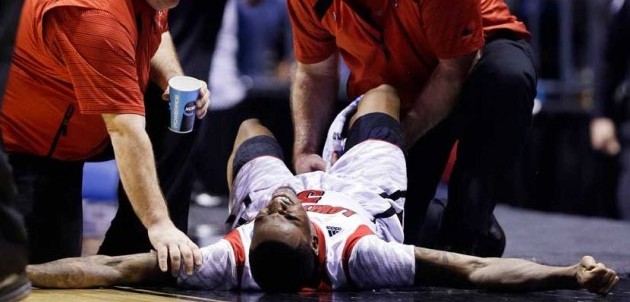
Pretty much since human beings began to stand upright, low back pain has been a part of daily life. Add in activities like weight lifting, jumping, twisting and running and the odds of that part of the body getting sore increase dramatically. Most low back pain is simply a strain caused when the tendons are pulled out of their normal range of motion. However, more serious back problems such as slipped or herniated discs can also occur from sports activity. If your back pain is severe or lasts longer than a week, it’s a good idea to visit your doctor.
Prevention: When it comes to preventing low-back injuries, whole-body stretching is critically important. Tight hamstrings or glutes are often implicated in low back pain, as they can pull on the pelvis, causing your back to become misaligned, so be sure to do stretching exercises that open these areas of the body in particular. Some common yoga poses such as downward dog, triangle pose and chair pose can help bring stability and flexibility into the low back area and prevent injuries. An excellent strengthening exercise is the plank because it works the core muscles both along the abdominal region and the back. The “superman” exercise can work well also. To execute this strengthening exercise, lie flat on a mat on the ground. Then, either raise both arms and legs at one time and hold, or do the same thing with alternating arms and legs (lift the left arm and right leg and vice versa).
In Case of an Injury

Despite best efforts, even the world’s most conditioned athletes fall prey to injuries from time to time. If you should suffer a sprain or low-grade injury that doesn’t require a visit to a doctor or emergency room, your best bet will be to likely follow the RICE regimen which stands for: Rest, Ice, Compression and Elevation. Rest is self-explanatory but proper icing might not be as intuitive. Experts recommend applying ice in the first 48 hours after an injury about 15 minutes at a time, with about 45 minutes between icing sessions. For compression, a simple ace bandaged wrapped around the injured joint or muscle should do the trick. Make sure the bandage is wrapped tightly, but not so tight that your fingers or toes turn blue. For the elevation component of injury recovery, it is recommended that you raise the injured body part above the level of the heart to reduce swelling and pain. If you have no allergy to it, you can also supplement this regimen with non-steroidal anti-inflammatories like ibuprofen or naproxen (Aleve). As the swelling and discoloration (if any) go down, you can begin doing very gentle stretching and strengthening exercises to get back in fighting form.
